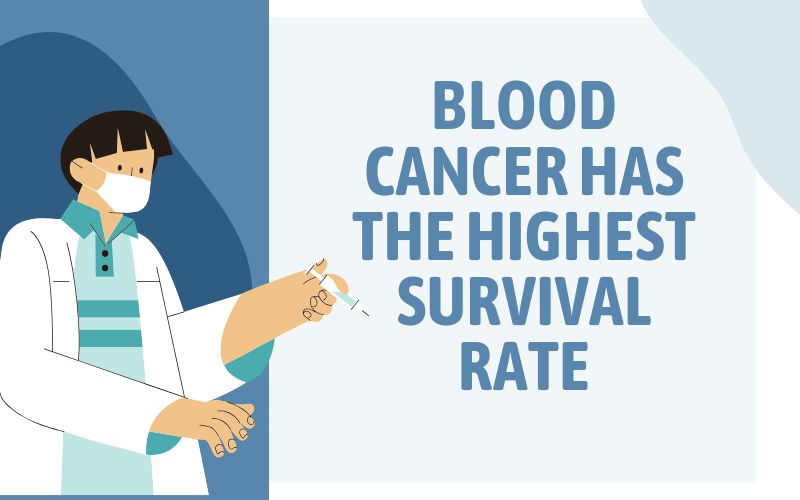Which blood cancer has the highest survival rate?
Blood cancers, also known as hematologic cancers, are cancers that affect the blood cancer, bone marrow, lymph, and lymphatic system. These cancers include leukemia, lymphoma, and myeloma, and they can have varying survival rates based on their specific type, the stage at diagnosis, and the individual’s overall health. Among these, survival rates differ significantly, and it is important to understand the factors that influence these rates. In terms of survival rate, Hodgkin lymphoma (HL) is often regarded as having the highest survival rate among blood cancers.
Types of Blood Cancer and Their Survival Rates
Blood cancers are generally categorized into three main types:
- Leukemia: A cancer of the bone marrow and blood that leads to the uncontrolled production of abnormal white blood cells. It is divided into different types, such as acute lymphoblastic leukemia (ALL), acute myeloid leukemia (AML), chronic lymphocytic leukemia (CLL), and chronic myelogenous leukemia (CML).
- Lymphoma: A cancer that affects the lymphatic system, which is part of the immune system. It includes Hodgkin lymphoma (HL) and non-Hodgkin lymphoma (NHL).
- Myeloma: A cancer that begins in the plasma cells of the bone marrow, which are responsible for producing antibodies. The most common form is multiple myeloma.
Hodgkin Lymphoma (HL) and Its Survival Rate
Hodgkin lymphoma (HL) is one of the most treatable blood cancers. It is a type of lymphoma that is characterized by the presence of Reed-Sternberg cells, which are abnormal cells that can be identified under a microscope. The exact cause of HL is not fully understood, but it is thought to involve a combination of genetic and environmental factors.
Do you want to visit Char Dham? Char Dham Travel Agent is the best place to plan your Char Dham tour. You can book the tour from here.
The survival rate for HL is remarkably high compared to other types of blood cancers. According to the American Cancer Society, the five-year relative survival rate for people with Hodgkin lymphoma is about 87% overall, with higher survival rates in younger patients. When the disease is diagnosed at an early stage, the survival rate can be even higher. In fact, with modern treatment methods, the survival rate for localized (stage I or II) Hodgkin lymphoma can exceed 90%.
The treatment for HL typically involves chemotherapy, radiation therapy, or a combination of both. In recent years, the use of immunotherapy drugs has also become more common, improving outcomes for patients with relapsed or refractory Hodgkin lymphoma. The survival rates have been steadily improving, thanks to these advancements in treatment.
Factors Contributing to High Survival Rates in Hodgkin Lymphoma
Several factors contribute to the high survival rate in Hodgkin lymphoma:
Would you like to visit Indiar? A tour operator in India is the best place to plan your tour. You can book a tour from here.
- Early Diagnosis: Hodgkin lymphoma is often diagnosed at an early stage, especially in younger individuals. Early diagnosis leads to higher success rates with treatments like chemotherapy and radiation.
- Advances in Treatment: Over the years, treatments for Hodgkin lymphoma have evolved significantly. The introduction of combination therapies, including chemotherapy and radiation, has dramatically improved survival rates. Moreover, the advent of immunotherapy has provided new hope for patients whose disease does not respond to traditional treatments.
- Young Age at Diagnosis: HL is most commonly diagnosed in individuals between the ages of 15 and 40, with a second peak in people over 55. Younger patients tend to have better overall health and are more likely to tolerate aggressive treatments like chemotherapy and radiation.
- Relatively Predictable Response to Treatment: Hodgkin lymphoma typically responds well to chemotherapy, especially in its early stages. The disease is often localized, meaning that it is confined to one area, which makes it easier to treat effectively.
Comparison with Other Blood Cancers
While Hodgkin lymphoma has an impressive survival rate, other blood cancers have varying survival outcomes.
- Acute Leukemias: Both acute lymphoblastic leukemia (ALL) and acute myeloid leukemia (AML) tend to have lower survival rates compared to Hodgkin lymphoma. The survival rate for ALL is around 70% in children, but it is much lower in adults. AML, on the other hand, has a five-year survival rate of approximately 27%. Acute leukemias are often more aggressive and can develop quickly, which makes early detection and treatment crucial. Treatment for leukemia typically involves chemotherapy, bone marrow or stem cell transplants, and targeted therapies, but the prognosis varies depending on the specific subtype and other factors.
- Chronic Leukemias: Chronic lymphocytic leukemia (CLL) and chronic myelogenous leukemia (CML) typically have a better prognosis than acute leukemias, but their survival rates are still lower than those for Hodgkin lymphoma. CLL is often a slow-progressing disease and can be managed with treatment, but it is not typically curable. CML has a better outlook, especially since the development of targeted therapies like tyrosine kinase inhibitors, which have greatly improved survival rates. For CML, the five-year survival rate is above 70%, and for CLL, the survival rate is around 85%.
- Non-Hodgkin Lymphoma (NHL): Non-Hodgkin lymphoma is a more diverse category of lymphoma, and its survival rates vary widely depending on the subtype. Some types of NHL, such as follicular lymphoma, have relatively high survival rates, especially if diagnosed early. However, aggressive forms of NHL, such as diffuse large B-cell lymphoma, can have a lower survival rate, especially in older patients. The overall five-year survival rate for NHL is approximately 72%, but this number can fluctuate significantly based on the subtype and the stage of the disease.
Conclusion
Among the various types of blood cancers, Hodgkin lymphoma has the highest survival rate, with a five-year survival rate of approximately 87%. This is due to a combination of factors, including early detection, effective treatment regimens, and the relatively predictable nature of the disease’s response to therapy. While survival rates for other blood cancers like acute leukemias, non-Hodgkin lymphoma, and multiple myeloma are improving with the development of new treatments, Hodgkin lymphoma remains the blood cancer with the highest survival rate.
Nonetheless, it’s important to note that survival rates can be influenced by many factors, including the specific type and stage of cancer, age, overall health, and how well a person responds to treatment. Advancements in medical research and the development of targeted therapies continue to improve outcomes for blood cancer patients across all types, offering hope for a brighter future in cancer treatment and survivorship.
Would you like to visit Haridwar? Travel agents in Haridwar are the best place to plan your trip. You can book your tour right here.
Read more – (Click here)






